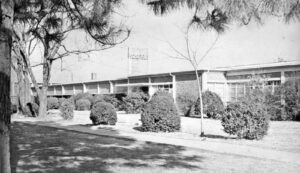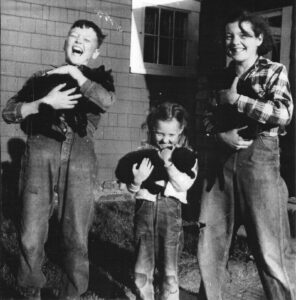Slowly bouncing down Devil’s Backbone trail on a gorgeous late winter’s morning in a four-wheel drive F-250 Ford loaded to the brim with water and firefighting apparatus, I quickly realized that I was in for a brand new perspective of The Hitchcock Woods and operations there.
The height of the truck afforded me a different view and perspective from my usual trekking vantage point on foot. My driver, tour guide, and professor for the day, Woods’ Superintendent Bennett Tucker, pointed out points of historical significance and interest not listed on the paper maps free to the public at every Woods entrance. I knew from the start it was going to be both an interesting and educational day.
As the caravan of vehicles set off from the shop at headquarters, the acrid smell of diesel fuel hung heavy in the morning air while all of the equipment was fueled for the job ahead, that equipment being the truck I rode in, a large John Deere tractor, and two UTVs (utility vehicles).
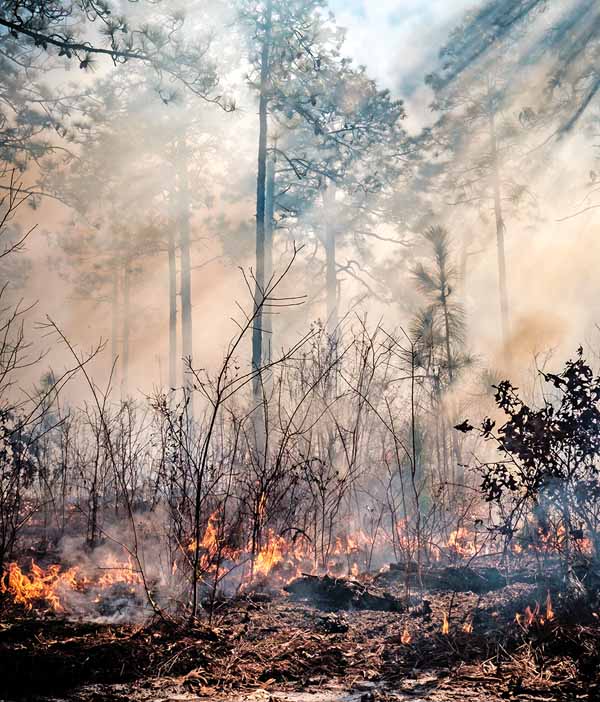
Meeting the Crew
I met the crew, namely Woods’ Resource Stewards Mike Grabowski and Frank Morelli, as well as volunteers for the day’s prescribed burn, Anne Kiser, Charlie Possee, and Robert Winston. Hitchcock Woods Foundation Board Member Randy Wolcott would join us shortly after smoke was going up in the air. Between the training and knowledge of Tucker and his staff and the years of experience of the volunteer crew with prior careers in forestry and firefighting, I found myself amidst a plethora of firefighting knowledge and experience. Gulp.

Tucker wears many hats in his role as Woods’ Superintendent: caretaker, prescribed burn manager, politician, and also someone with a genuine love for The Woods. Growing up nearby, he spent much of his earlier life exploring Hitchcock Woods and now, as a married father of two, he cares for it as a profession. He truly knows the 70-plus miles of sandy trails and paths as well as – if not better than – the back of his own hands. Numerous times I’ve posted random photographs of a tree, flower, trailhead, or sunset from my walk, and he identified its location precisely.
Passing the horse show ring, we continued down to one of the main intersections of trails and began an uphill course towards the western edge of the property. On a trail I’d never personally walked, he pointed out the area of the old brick factory – hence the name Brickyard Fields on the map. Finally crossing the power line running in from the Rt. 118 bypass, we reached a staging area where we unloaded gear and made a final check of the weather via smartphones and also with a handheld Kestrel, a device that measures both air temperature, relative humidity, and wind speed.
Testing for Safety and Success
Before we left the shop, the burn plan was called in to the State Forestry Commission, and we got a green light. The crew lit a drip-torch containing a mixture of diesel fuel and gasoline, and smoke soon emanated from a small patch of ground where Morelli laid a test fire for a final weather check and to ensure that the fire and smoke would behave in the desired manner.
At 2,100 acres, Hitchcock Woods is the largest privately owned urban forest in the country. If you’re a frequent visitor there on foot or astride a horse, you may have noticed to some degree the effects of prescribed fire in The Woods. For most of us, that means we’ve seen or smelled smoke while burns are taking place, noticed the “Burn Today” signs at various points on the roads lining the perimeter of the woods, or have noticed the blackened areas and ensuing rebirth of a section of woods as we’ve passed through it.
While fire is elemental, requiring only the three components of heat, air, and fuel, the business of prescribing fire is scientific, with the science getting better and more accurate over time.
How the Burn is Conducted
Fire is “prescribed” in advance. The scientific prescription is prepared indicating objectives, fuels present, size of the area to be burned, conditions under which the fire will burn optimally, and the conditions that will factor into suppression if it proves necessary.
With all conditions in alignment, the staff spread out to their posts on the downwind side of the block to start the day off. The UTVs had tanks and hoses to monitor the fire, and strings of fire were laid on the edges. Soon, smoke filled the air and dissipated quickly into the upper atmosphere. Smoke management is one of the biggest challenges in an urban setting such as Hitchcock Woods. If smoke went billowing out onto Rt. 118, it would reduce visibility for traffic, endangering public safety.
With the fire well under way, staff and volunteers took turns laying spots of fire ahead of the original line, crisscrossing the block of woods to speed up the process and preheating some of the fuel to ensure a more thorough burn of the fuel sources. Everything was going according to the prescription as I hopped in a UTV nicknamed the “Uber” with Tucker to go on a smoke patrol, the goal being to ensure that smoke was lifting and not hanging low or creating any undue strain on the neighbors in Foxchase just to the east of the burn.
As we rounded the boundary at the edge of the power line and Foxchase, Tucker momentarily changed hats from burn manager to politician as he answered the call of a resident in her pasture tending to her horse. Concerns listened to, answered, and pleasantries exchanged, we continued the loop and headed back into the block of active fire.
The Return of the Red-Cockaded Woodpeckers
Hitchcock Woods is actively transitioning its forest back to the native longleaf pine that dominated our region long before man ever arrived here. A fire-dependent ecosystem that developed over millions of years, longleaf forests are a natural home to federally endangered red-cockaded woodpeckers (RCWs). Randy Wolcott was the driving force behind a project that reintroduced RCWs to the forest via a symbiotic relationship with state, federal, and private partners. Much has been written of this program’s success. Artificial nesting cavities have been installed in certain blocks of longleaf pines where RCWs caught in Francis Marion Nation Forest were translocated.
The block to be burned that morning contained an active nesting site in old longleafs. Extreme care was taken to remove the fuels – straw, vines, grasses, brush – by hand from the base of the nest trees to lessen chances that fire would climb the trees and cause damage to the cavities. By all accounts, the reintroduction of RCWs has been a success. Some of you may have caught sight of the majestic birds or heard their unique sounds as you’ve enjoyed the woods. With luck and some hard work, their numbers and voices will continue to increase in Hitchcock Woods for years to come.
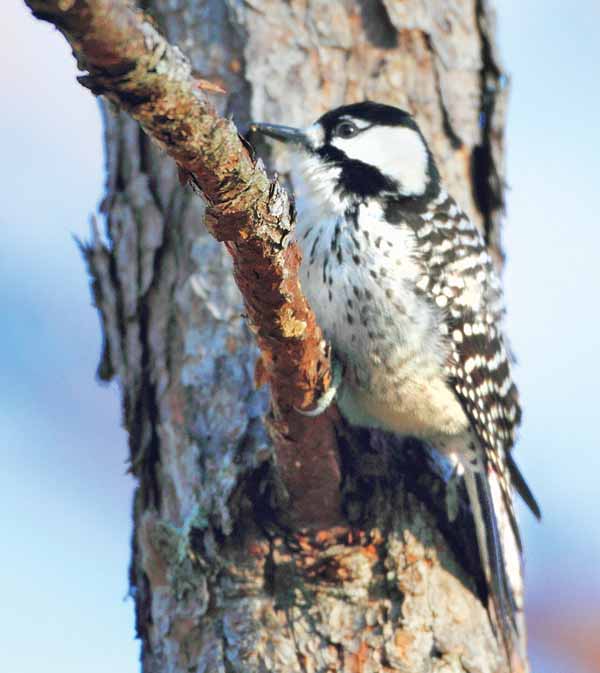
Working Toward “In the Black”
A small hot-spot on one tree was quickly dealt with via the Woods’ brush truck. Tucker noted that through the generosity of a Friend of The Woods that they now have their own brush truck and are able to plan their prescribed burns more effectively without having to rely on outside resources. They are also able to respond quickly if a fire pops up from a lighting strike or a grass fire along one of the boundary roads.
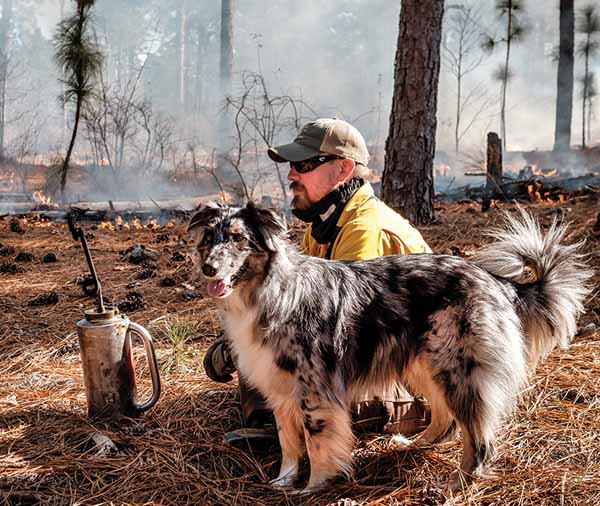
The day continued in a whirl of constant smoke and motion, with no real break. Members of the burn team were all clad in green nomex pants and yellow shirts of the same material. Two-way radios, hard hats, and camelback hydration packs rounded out their gear. As the fire from the morning burn consumed the last of its fuel, members of the staff circled the perimeter to ensure that no hot-spots or flareups would catch them by surprise. Meanwhile, Tucker and Grabowski brought out their Kestrel device again for another check of wind, relative humidity, and temperature. After consulting their book of burn plans, they finally dialed the Forestry Commission for a green light to attack the second block of woods planned for that day.
By the time Bennett and I arrived at the next block in the brush truck, a sizable portion of the fire line had been laid, and smoke was in the air heading up. “Sparky,” a four-wheeler fitted with a pump-fed ignition device, was used to string fire in a more expedient manner on some sections of this burn. Several of the burn crew flanked areas of this burn, and in short order they had reduced it to smoldering embers, or “in the black,” their term for a recently burned area that provides safe buffers for future burns occurring within adjoining blocks of the forest. Later, a small commotion could be seen among the trees as bluebirds and others descended on the still-smoking block of woods for a feast of barbecued bugs and grubs.
Experience Counts
As the day began to wind down, some of the volunteer crew assembled upwind of the fire for a needed break. I overheard several conversations related to their career experiences with federal and state agencies fighting major wildland fires. Those of us who enjoy the outdoors like to reminisce about the one that got away when a fish broke our line or a missed opportunity at a trophy deer. These men and women reminisce about major fires they were personally involved in, ones that made headlines. They wear their confidence well, earned through years of protecting people and forests. With their vast knowledge and experiences, these volunteers are welcome and valued additions to Tucker’s burn team.
One of the most important and beneficial aspects of controlled burns in an urban-wildland interface such as Hitchcock Woods is the mitigation of unintended fires. If a lightning strike starts a fire naturally, containment of a fire and extinguishing it is much easier because the annual burns have lessened the fuel load on the forest floor. This is of great benefit to the residents who live on the boundary with The Woods: Aiken Estates, Foxchase, and the Dibble Road corridor. By carefully controlling the fuel on the forest floor with prescribed fire in the interior and exterior areas of The Woods, the risk of catastrophic fire is dramatically lessened for those residents, their structures, and the many horses that pasture near the perimeter of the forest.
Controlled burns were not held in the Woods for a period of years toward the end of the 20th century ago. Evidence of their importance was demonstrated in the early 2000s when prescribed fire was reinstituted in The Woods, and one section with an extremely built-up duff layer (the layer of decomposing organic matter on the forest floor) smoldered and periodically reignited for weeks. A great number of resources and man-hours were required to watch the fire continually and ensure that it remained under containment and was ultimately put out. While prescribed fire happens under exacting meteorological conditions and predicted forecasts, anomalies are possible. It was just such a set of conditions that contributed to this duff fire: a forecast of rain developing at the conclusion of the burn that didn’t come to fruition, combined with the unusual fire behavior in the duff layer that accumulated over many years when no controlled burning had occurred.
New Life Spring from the Fire
Three weeks after I joined the Woods crew to observe their prescribed fire practices, I walked through one of the blocks burned that day and found a fresh bed of green ferns sprouting from the forest floor. The recycled nutrients from prescribed fire will turn those blocks into verdant green ecosystems by summer. Some of the native warm season grasses are dependent upon fire to take root and grow with the help of the spring and summer rains.
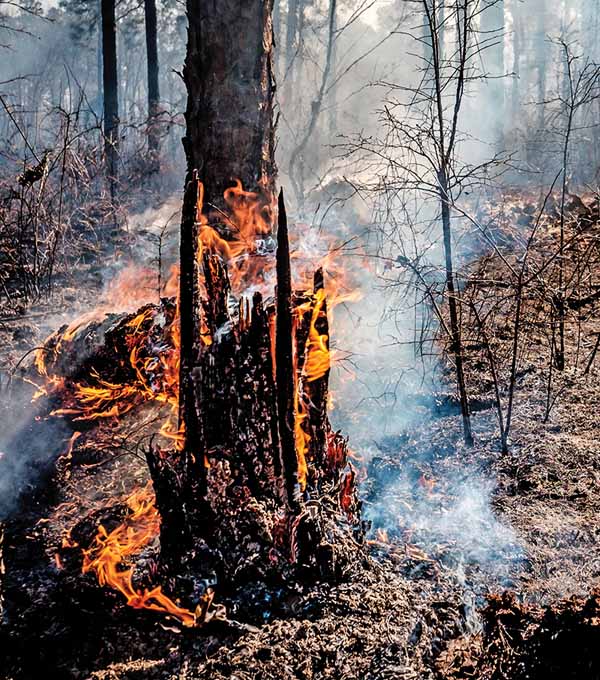
In the weeks since my time spent with the crew and the writing of this piece, Tucker and his crew switched hats to set up and then disassemble the ring for the 103rd Aiken Horse Show held during the final weekend of March. With the forest almost in almost full greenery now, those hats will become burn hats again during late spring and summer, as weather allows for more prescribed burns. The burns coming up are known as growing season burns, versus the dormant season burn I witnessed. A benefit of the growing season burns is that they reduce the hardwood scrub oak competition and allow another layer of herbaceous groundcover restoration. According to Tucker, some native grasses actually depend on fire to regenerate.
Appreciating the Stewards of The Woods
The day spent afield with Tucker and his crew of professionals was educational indeed. Aiken is fortunate to have Hitchcock Woods in the center of our city, offering us myriad recreational opportunities. The next time you’re in The Woods and pass by a block freshly “in the black,” I hope you’ll have a better understanding of the prescription burning practices that help to keep our forest a vibrant and healthy ecosystem. You’ll develop an appreciation of the hard work and dedication of the Hitchcock Woods Foundation, its staff, and dedicated volunteers, true professionals in maintaining Aiken’s Crown Jewel.


Rob Heilig was born in the old Aiken Hospital and graduated from Aiken High School and The Citadel. He scours the back roads of South Carolina in search of chili-dawgs and interesting things. Sometimes he writes about them.


